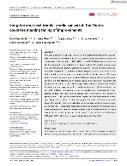Long-term survival trends in solid cancers in the Nordic countries marking timing of improvements

Author
Försti, Asta
Kanerva, Anna
Hemminki, Otto
Hemminki, Akseli
Publication date
2023Published in
International Journal of CancerVolume / Issue
152 (9)ISBN / ISSN
ISSN: 0020-7136Metadata
Show full item recordCollections
This publication has a published version with DOI 10.1002/ijc.34416
Abstract
Survival studies are an important indicator of the success of cancer control. We analyzed the 5-year relative survival in 23 solid cancers in Denmark, Finland, Norway and Sweden over a 50-year period (1970-2019) at the NORDCAN database accessed from the International Agency for Research on Cancer website. We plotted survival curves in 5-year periods and showed 5-year periodic survival. The survival results were summarized in four groups: (1) cancers with historically good survival (>50% in 1970-1974) which include melanoma and breast, endometrial and thyroid cancers; (2) cancers which constantly improved survival at least 20% units over the 50 year period, including cancers of the stomach, colon, rectum, kidney, brain and ovary; (3) cancer with increase in survival >20% units with changes taking place in a narrow time window, including oral, oropharyngeal, testicular and prostate cancers; (4) the remaining cancers with <20% unit improvement in survival including lung, esophageal, liver, pancreatic, bladder, soft tissue, penile, cervical and vulvar cancers. For cancers in groups 1 and 2, the constant development implied multiple improvements in therapy, diagnosis and patient care. Cancers in group 3 included testicular cancers with known therapeutic improvements but for the others large incidence changes probably implied that cancer stage (prostate) or etiology (oropharynx) changed into a more tractable form. Group 4 cancers included those with dismal survival 50 years ago but a clear tendency upwards. In 17 cancers 5-year survival reached between 50% and 100% while in only six cancers it remained at below 50%.
Keywords
early diagnosis, periodic survival, prognosis, relative survival, treatment
Permanent link
https://hdl.handle.net/20.500.14178/1957License
Full text of this result is licensed under: Creative Commons Uveďte původ-Neužívejte dílo komerčně 4.0 International







